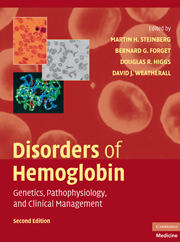Book contents
- Frontmatter
- Contents
- List of Contributors
- Foreword, by H. Franklin Bunn
- Preface
- Introduction, by David J. Weatherall
- SECTION ONE THE MOLECULAR, CELLULAR, AND GENETIC BASIS OF HEMOGLOBIN DISORDERS
- SECTION TWO PATHOPHYSIOLOGY OF HEMOGLOBIN AND ITS DISORDERS
- SECTION THREE α THALASSEMIA
- 13 The Molecular Basis of α Thalassemia
- 14 The Pathophysiology and Clinical Features of α Thalassaemia
- 15 Unusual Types of α Thalassemia
- SECTION FOUR THE β THALASSEMIAS
- SECTION FIVE SICKLE CELL DISEASE
- SECTION SIX OTHER CLINICALLY IMPORTANT DISORDERS OF HEMOGLOBIN
- SECTION SEVEN SPECIAL TOPICS IN HEMOGLOBINOPATHIES
- SECTION EIGHT NEW APPROACHES TO THE TREATMENT OF HEMOGLOBINOPATHIES AND THALASSEMIA
- Index
- Plate section
- References
14 - The Pathophysiology and Clinical Features of α Thalassaemia
from SECTION THREE - α THALASSEMIA
Published online by Cambridge University Press: 03 May 2010
- Frontmatter
- Contents
- List of Contributors
- Foreword, by H. Franklin Bunn
- Preface
- Introduction, by David J. Weatherall
- SECTION ONE THE MOLECULAR, CELLULAR, AND GENETIC BASIS OF HEMOGLOBIN DISORDERS
- SECTION TWO PATHOPHYSIOLOGY OF HEMOGLOBIN AND ITS DISORDERS
- SECTION THREE α THALASSEMIA
- 13 The Molecular Basis of α Thalassemia
- 14 The Pathophysiology and Clinical Features of α Thalassaemia
- 15 Unusual Types of α Thalassemia
- SECTION FOUR THE β THALASSEMIAS
- SECTION FIVE SICKLE CELL DISEASE
- SECTION SIX OTHER CLINICALLY IMPORTANT DISORDERS OF HEMOGLOBIN
- SECTION SEVEN SPECIAL TOPICS IN HEMOGLOBINOPATHIES
- SECTION EIGHT NEW APPROACHES TO THE TREATMENT OF HEMOGLOBINOPATHIES AND THALASSEMIA
- Index
- Plate section
- References
Summary
INTRODUCTION
The primary abnormality in patients with α thalassemia is the underproduction of α-globin chains. Important secondary effects occur because of the continued production of excess γ chains in fetal life, which form the γ4 tetramer (Hb Bart's) and excess β-chains in adult life producing a β4 tetramer (HbH). Excess, unmatched non-α-globin chains damage the developing erythroid precursors, giving rise to intramedullary hemolysis or ineffective erythropoiesis. In addition, the presence of Hb Bart's and HbH cause premature destruction of mature red cells, giving rise to the predominant pathophysiology of α thalassemia that involves extravascular hemolysis.
As set out in Chapter 13 and http://globin.bx.psu.edu/hbvar/ we currently know of approximately 80 mutations associated with α+ thalassemia and approximately 40 that cause α0 thalassemia. There are potentially several hundred different interactions that could take place between the large numbers of determinants described. Phenotypically, these interactions result in one of three broad categories; α thalassemia trait, in which there are mild hematological changes but no major clinical abnormalities, HbH disease, and the Hb Bart's hydrops fetalis syndrome. We shall consider each of these in this chapter.
The information set out in Chapter 13 suggests that the α thalassemia determinants can be arranged in the order of their severity (from αα to --) as shown in Table 14.1. In general the phenotypes resulting from their interactions correlate well with the reduction in α-chain synthesis predicted for each mutation.
- Type
- Chapter
- Information
- Disorders of HemoglobinGenetics, Pathophysiology, and Clinical Management, pp. 266 - 295Publisher: Cambridge University PressPrint publication year: 2009
References
- 7
- Cited by



